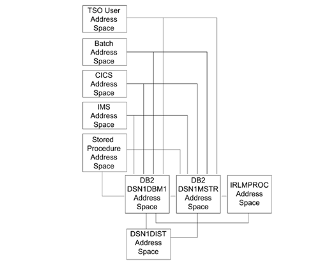DB2 Is a Relational DBMS developed by IBM for
computers running under MVS, its most advanced operating system for large
computers. DB2 supports SQL (structured query language), which has been
standardized by ANSI (American National Standards Institutes) and ISO
(International Standards Organization) and has become the standard for all
relational DBMS.
DB2 use call attachment facility to operate under three MVS subsystems environments : IMS, CICS, and TSO.
These subsystems cooperate
with DB2 facilities to provide such services as data communications and control
of transactions, which are group of database operations that must be coordinated
to avoid the introduction of errors.DB2 use call attachment facility to operate under three MVS subsystems environments : IMS, CICS, and TSO.
CICS is a teleprocessing monitor, a program for
controlling online transactions those that execute as they are entered from a
terminal allowing users to interact with the computer. IMS/DB/DC is a well
established non relational DBMS, which includes a teleprocessing monitor. TSO
also contains a teleprocessing monitor that can be used by DB2. DB2 applications
running under TSO may be online or batch.
CICS attachment facility - A DB2
subcomponent that uses the MVS subsystem interface (SSI) and cross storage
linkage to process requests from CICS to DB2 and to coordinate resource
commitment.
IMS attachment facility - A DB2
subcomponent that uses MVS subsystem interface (SSI) protocols and cross-memory
linkage to process requests from IMS to DB2 and to coordinate resource
commitment.
TSO attachment facility - A DB2
facility consisting of the DSN command processor and DB21. Applications that are
not written for the CICS or IMS environments can run under the TSO attachment
facility.
DB2 Address space.
The address spaces used in the operation of DB2
are
* System services address space (SSAS)
* Database services address space (DSAS)
* Internal resource lock manager (IRLM)
* Distributed Database Facility (DDF)
* Stored procedure address space (SPAS)
* Allied address spaces
* Database services address space (DSAS)
* Internal resource lock manager (IRLM)
* Distributed Database Facility (DDF)
* Stored procedure address space (SPAS)
* Allied address spaces

SSAS - The system services
address space, also called the Data System Control Facility (DSCF) address
space, is the DSN1MSTR address space. The following subcomponents execute in the
SSAS are :
* General command processor
* Subsystem support
* Agent services manager
* Storage manager
* Message generator
* Initialization procedures
* Instrumentation facilities
* System parameter manager
* Recovery manager
* Recovery log manager
* Group manager
* Distributed transaction manager
* Subsystem support
* Agent services manager
* Storage manager
* Message generator
* Initialization procedures
* Instrumentation facilities
* System parameter manager
* Recovery manager
* Recovery log manager
* Group manager
* Distributed transaction manager
DSAS -
This is critical, as it manages most of the activities in DB2. The
database services address space, also called the Advanced Database Management
Facility (ADMF) address space, is the DSNDBM1 address space. The following
subcomponents execute in the DSAS are:
* Service controller
* Data manager
* Large-object manager (LOBM)
* Data space manager
* Relational data system (RDS)
* Stored-procedures manager
* Utilities (work with associated code in an allied address space)
* Buffer manager
* Data manager
* Large-object manager (LOBM)
* Data space manager
* Relational data system (RDS)
* Stored-procedures manager
* Utilities (work with associated code in an allied address space)
* Buffer manager
IRLM - Each DB2 subsystem has its
own internal resource lock manager. The IRLM controls access to the application
data and is used by DB2 as the lock manager to ensure the integrity of the
data.
DDF - The Distributed Data
Facility allows client applications running in an environment that supports
Distributed Relational Database Architecture (DRDA) to access DB2 data. The DDF
also allows for one DB2 subsystem to access data on another DB2 subsystem. Other
relational database servers can be accessed if they support DRDA. TCP/IP and SNA
(Systems Network Architecture) are the supported network protocols.
SPAS - The stored-procedure
address space (DSN1SPAS) is established by DB2. SPAS provides an isolated
environment in which to execute stored procedures.
Allied Address Space - The allied
address spaces communicate with DB2. The SPAS operate as allied address spaces.
The following subcomponents execute in allied address spaces:
* Attachment facilities: call attachments,
CICS, IMS, recover, TSO.
* Utilities: DDAS; standalone
* Utilities: DDAS; standalone
Database Request Module
The pre-compiler output include a database request
module (DBRM) which contains SQL statements extracted from the source program.
The SQL statements in a DBRM are those executable statements that must be bound
before they can be executed. The DBRM is kept as a member of a partitioned data
set (library) and is given the name of the program. It also contains a
consistency token to distinguish it from other DBRM derived from other versions
of the program.
Bind Process.
The bind process establishes a relationship
between an application program and its relational data. This step is necessary
before a program can be executed. DB2 allows two basic ways of binding a
program: to a package or directly
to an application plan
DB2 Object
A DB2 object is something that can be defined
using an SQL CREATE statement The objects are classified as follows :
* Tables Indexes
* Views
* Table spaces
* Storage groups
* Data bases
* Synonyms
* Aliases
* Views
* Table spaces
* Storage groups
* Data bases
* Synonyms
* Aliases
DB2 Catalog
Each DB2 maintains a set of tables containing
information about the data it manages. These tables are collectively known as
the catalog. The catalog tables contain information about DB2 objects such as
tables, views, and indexes. With appropriate authorization, you can retrieve
data from catalog tables by using SQL statements, just as you would with any
other table. Each DB2 ensures that at all times its catalog contains accurate
descriptions of the objects that the DB2 controls.
No comments:
Post a Comment